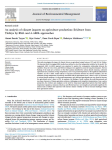Tayyar A.E., Gasim N., Biçen Ö.F., Mukhtarov S. (2025). An analysis of climate impacts on agriculture production: evidence from Türkiye by BMA and A-ARDL approaches. Journal of Environmental Management, 01/08/2025, vol. 389, p. 126111.
https://doi.org/10.1016/j.jenvman.2025.126111
https://doi.org/10.1016/j.jenvman.2025.126111
| Titre : | An analysis of climate impacts on agriculture production: evidence from Türkiye by BMA and A-ARDL approaches (2025) |
| Auteurs : | A.E. Tayyar ; N. Gasim ; Ö.F. Biçen ; S. Mukhtarov |
| Type de document : | Article |
| Dans : | Journal of Environmental Management (vol. 389, August 2025) |
| Article en page(s) : | p. 126111 |
| Langues : | Anglais |
| Langues du résumé : | Anglais |
| Catégories : |
Catégories principales 07 - ENVIRONNEMENT ; 7.6 - Changement ClimatiqueThésaurus IAMM CHANGEMENT CLIMATIQUE ; EVALUATION DE L'IMPACT ; PRODUCTION AGRICOLE ; TURQUIE |
| Résumé : | This study investigates the impact of climatic factors on agricultural output between 1970 and 2022 in Türkiye. The Bayesian Model Averaging (BMA) method was utilized to select the independent variables for the model. The augmented ARDL (A-ARDL) approach was employed to analyze the cointegration relationship between the variables. Then, the CCR, DOLS, and FMOLS techniques were applied to assess the long-term dynamics. The key findings of the study are as follows: (i) The BMA analysis identified the carbon dioxide emissions, cultivated agricultural area, minimum average temperature, and 10 cm ground temperature as the significant independent variables. (ii) The A-ARDL results indicate a long-term association between the selected variables. (iii) The minimum average temperature is positively associated with the agricultural sector's share in GDP. (iv) Increases in carbon dioxide emissions, 10 cm ground temperature, and cultivated agricultural area were found to decrease the agricultural sector's share in GDP. In summary, the findings of study confirms the multi-dimensioned and non-linear character of climate-agriculture relations, challenging overly simplistic interpretations. From a policy perspective, the evidence puts emphasis on the need for climat-smart agricultural policies that bind together temperature regulation, emissions reduction, and efficient land use. Such insights are particularly significant for nations such as Türkiye that experience both extreme climatic volatility as well as structural challenges within their agricultural systems. |
| Cote : | Réservé lecteur CIHEAM |
| URL / DOI : | https://doi.org/10.1016/j.jenvman.2025.126111 |







